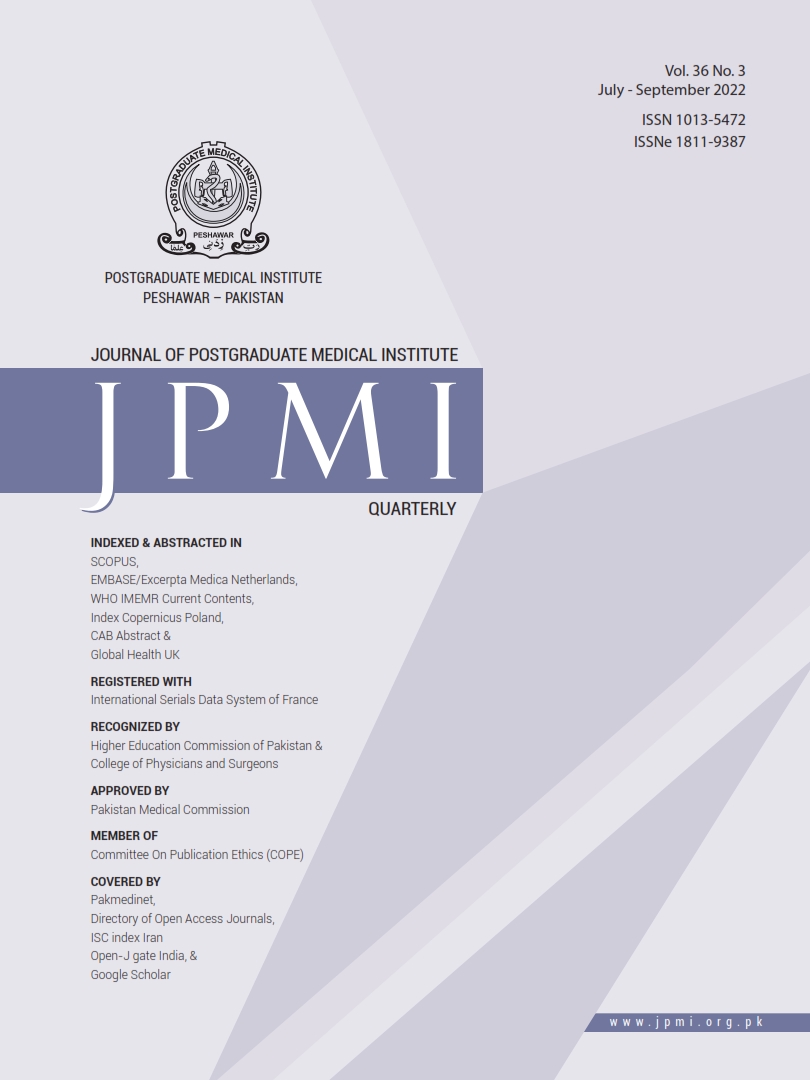COMPARISON OF EFFICACY OF 1-WEEK ORAL AZITHROMYCIN WITH 2-WEEK TOPICAL 1% AZITHROMYCIN EYE DROPS IN THE TREATMENT OF POSTERIOR BLEPHARITIS
Main Article Content
Abstract
Objective: To assess the efficacy of 1-week of oral azithromycin (AM) with 2 weeks of topical azithromycin eye drops in posterior blepharitis patients.
Methodology: In this quasi-experimental study, 80 participants were enrolled (>45 years old) with meibomian gland dysfunction (MGD) at the Department of Ophthalmology, Qazi Hussain Ahmed Medical Complex, Nowshera from January to September 2020. Patients were allocated to get either 1-week of oral azithromycin (500mg/day) or 2 weeks of continued topical azithromycin 1% once daily. A scoring system was devised which included 5 symptoms and 7 signs which were assessed at baseline and follow-ups on 1st, 2nd, and 4th-week post-therapy. The total score was documented at the end of the study by summing up the symptoms and signs score.
Results: The objective and subjective features of the disease showed improvement with either therapy, however, 2 weeks of topical azithromycin 1% once a day showed significantly more improvements (p= 0.008). We observed improvement in the symptoms of disease in both groups but that didn’t achieve the level of statistical significance between the groups (0.242). Systemic side effects in the form of anorexia, nausea, and gastrointestinal upsets were negligible in topical Azithromycin as compared to its oral form.
Conclusion: Both oral and topical forms of drugs effectively ameliorated the symptoms of posterior blepharitis, however, 2 weeks of topical azithromycin 1% once a day also addressed the signs of the disease along with benefits of having better tolerance (least gastrointestinal upsets) leading to improved compliance in comparison to its oral form.
Article Details
Work published in JPMI is licensed under a
Creative Commons Attribution-NonCommercial 2.0 Generic License.
Authors are permitted and encouraged to post their work online (e.g., in institutional repositories or on their website) prior to and during the submission process, as it can lead to productive exchanges, as well as earlier and greater citation of published work.
References
Nichols KK, Foulks GN, Bron AJ, Glasgow BJ, Dogru M, Tsubota K, et al. The international workshop on meibomian gland dysfunction: Executive summary. Invest Ophthalmol Vis Sci. 2011; 52(4):1922- 9. DOI:10.1167/iovs.10-6997a.
Romero JM, Biser SA, Perry HD, Levinson DH, Doshi SJ, Terraciano A, et al. Conservative treatment of meibomian gland dysfunction. Eye Contact Lens. 2004;30(1):14-19. DOI:10.1097/01. ICL.0000095229.01957.89.
Guillon M, Maissa C, Wong S. Eyelid margin modification associated with eyelid hygiene in anterior blepharitis and meibomian gland dysfunction. Eye Contact Lens. 2012;38(5):319-25. DOI:10.1097/ ICL.0b013e318268305a.
Igami TZ, Holzchuh R, Osaki TH, Santo RM, Kara-Jose N, Hida RY. Oral azithromycin for treatment of posterior blepharitis. Cornea. 2011; 30:145-9. DOI:10.1097/ICO.0b013e318207fc42.
Geerling G, Tauber J, Baudouin C, Goto E, Matsumoto Y, O'Brien T, et al. The international workshop on meibomian gland dysfunction: report of the subcommittee on management and treatment of meibomian gland dysfunction. Invest Ophthalmol Vis Sci. 2011;52(4):2050-64. DOI:10.1167/ iovs.10-6997g.
Foulks GN, Borchman D, Yappert M, Kakar S. Topical azithromycin and oral doxycycline therapy of meibomian gland dysfunction: a comparative clinical and spectroscopic pilot study. Cornea. 2013;32:44-53. DOI:10.1097/ ICO.0b013e318254205f.
Foulks GN, Borchman D, Yappert M, Kim SH, McKay JW. Topical azithromycin therapy for meibomian gland dysfunction: clinical response and lipid alterations. Cornea. 2010;29(7):781-8. DOI:10.1097/ICO.0b013e3181cda38f.
Bertino JS Jr. Impact of antibiotic resistance in the management of ocular infections: the role of current and future antibiotics. Clin Ophthalmol. 2009;3:507-21. DOI:10.2147/opth. s5778.
Balci O, Gulkilik G. Assessment of efficacy of topical azitromycin 1.5% ophthalmic solution for the treatment of meibomian gland dysfunction. Clin Exp Optom. 2018; 101:18-22. DOI:10.1111/cxo.12557.
Hosseini K, Lindstrom RL, Foulks G,. Arandomized, double masked, parallel-group, comparative study to evaluate the clinical efficacy and safety of 1% azithromycin-0.1% dexamethasone combination compared to 1% azithromycin alone, 0.1% dexamethasone alone, and vehicle in the treatment of subjects with blepharitis. Clin Ophthalmol. 2016;10:1495-1503. DOI:10.2147/OPTH.S110739.
Zandian M, Rahimian N, Soheilifar S. Comparison of therapeutic effects of topical azithromycin solution and systemic doxycycline on posterior blepharitis. Int J Ophthalmol. 2016; 9:1016-19. DOI:10.18240/ijo.2016.07.14.
Al-Hity A, Lockington D. Oral azithromycin as the systemic treatment of choice in the treatment of meibomian gland disease. Clin Exp Ophthalmol. 2016;44:199-201. DOI:10.1111/ceo. 12666.
Friedlander MH, Protzko E. Clinical development of 1% azithromycin in DuraSite, a topical azalide anti-infective for ocular surface therapy. Clin Ophthalmol. 2007;1:3-10.
Luchs J. Azithromycin in DuraSite for the treatment of blepharitis. Clin Ophthalmol. 2010; 4:681-8. DOI:10.2147/ opth.s6370.
John T, Shah AA. Use of azithromycin ophthalmic solution in the treatment of chronic mixed anterior blepharitis. Ann Ophthalmol (Skokie). 2008;40:68-74.
Luchs J. Efficacy of topical azithromycin ophthalmic solution 1% in the treatment of posterior blepharitis. Adv Ther. 2008;25:858-70. DOI:10.1007/ s12325-008-0096-9.
Yildiz E, Yenerel NM, Turan-Yardimci A, Erkan M, Gunes P. Comparison of the Clinical Efficacy of Topical and Systemic Azithromycin Treatment for Posterior Blepharitis. J Ocul Pharmacol Ther. 2018 May;34(4):365-372. DOI 10.1089/jop.2017.0095
Fadlallah A, Rami HE, Fahd D,. Azithromycin 1.5 % ophthalmic solution: efficacy and treatment modalities in chronic blepharitis. Arq Bras Oftalmol. 2012;75:178-182. DOI:10.1590/ s0004-27492012000300006.


